Content
Published:
This is an archived release.
Fewer thefts, but more narcotic offences
In 2013, 388 500 offences were reported to the police in Norway; 1.3 per cent less than the year before. There has been a significant drop in reported thefts, and the number of thefts is lower than during the past 20 years of comparable statistics. The number of narcotic offences reported to the police, however, was higher in 2013 than in all of the previous years.
| 2013 | Change in per cent | ||||
|---|---|---|---|---|---|
| 2012 - 2013 | 2008 - 2013 | 2003 - 2013 | 1998 - 2013 | ||
| Offences reported | 388 506 | -1.3 | 0.6 | -7.7 | -6.5 |
| Offences reported per 1 000 population | 76.9 | -2.7 | -5.6 | -16.8 | -18.2 |
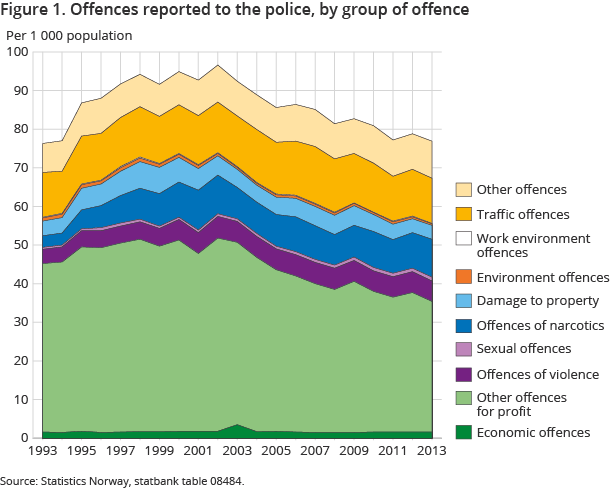
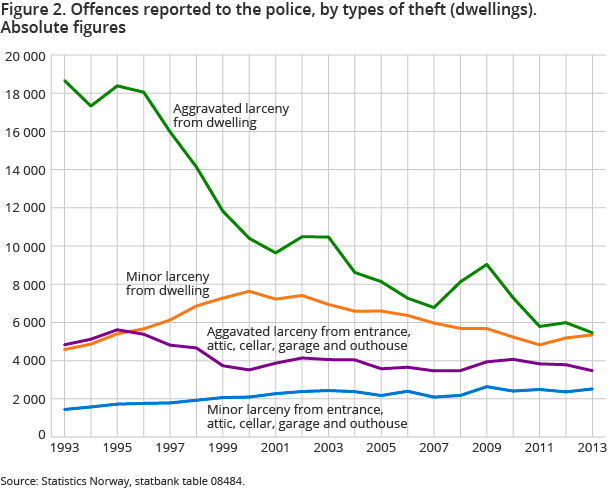
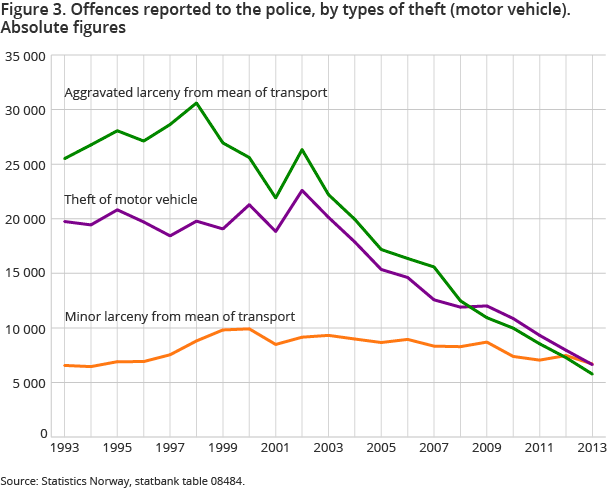
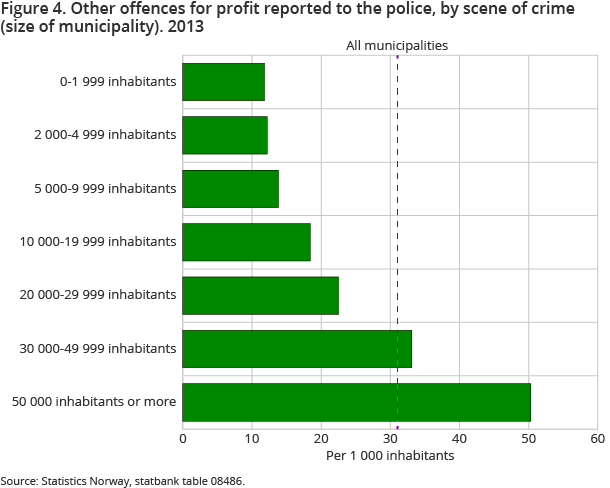
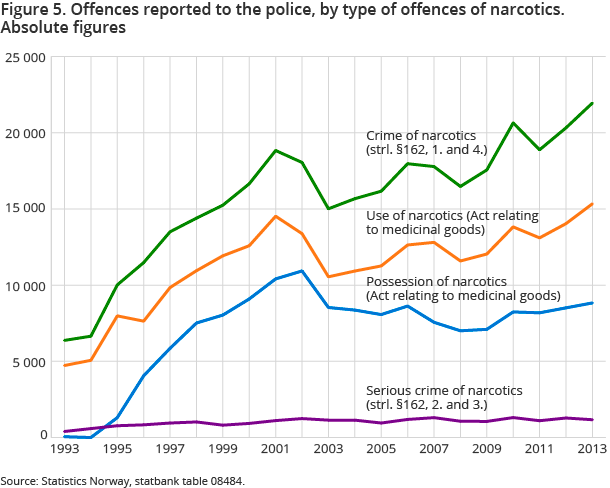
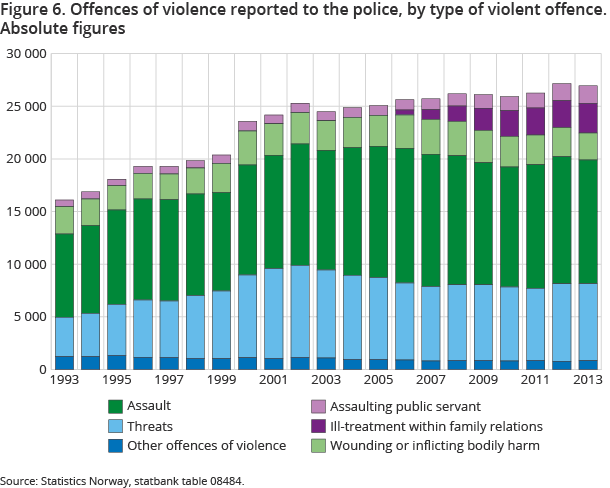
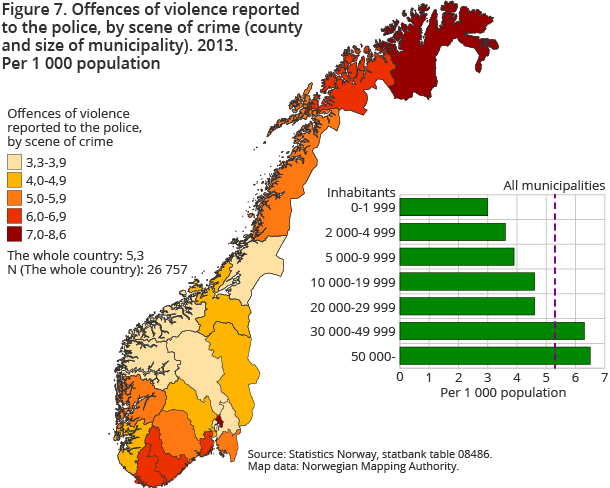
In 2013, a total of 170 900 thefts and other types of offences for profit were reported to the police. This is 9 000 fewer than the year before. The large increase in offences for profit from 2011 to 2012 was therefore more than reversed, and the scale of these kinds of offences is now lower than in all preceding years of corresponding statistics. Compared to the year before, 1 500 fewer traffic misdemeanours was also reported in 2013, primarily due to a drop in reported incidents of road users without driving licences. On the contrary, however, there were 3 500 more reported narcotic offences and 2 200 more offences in the group “Other offences”.
Thus, in total, other offences for profit made up 44 per cent of the 388 500 offences reported to the police in 2013. This is a significantly smaller share than for example ten years earlier, when this group of offence made up more than half of all reported offences. Traffic misdemeanours made up 15.2 per cent of all offences in 2013, while narcotic offences and the group of “other offences” made up 12.7 and 12.4 per cent respectively.
Further decrease in reported crime in Norway
The last ten years of statistics show that even though the total number of offences reported to the police varies from year to year, the net trend is fewer reported offences. The notion of a decline in registered crime in Norway is enhanced when we consider three underlying changes from the last couple of years:
First of all, there has been a considerable growth in population, and for example when measuring the total number of offences per 1 000 population, the crime volume in 2013 is 2.6 per cent lower than in 2012 and 10.1 per cent lower in 2013 than in 2005 (see figure 1).
Secondly, offences with the scene of crime reported to be abroad makes up a growing share of the total number of offences. In 2013, 14 200 offences where reported to have happened outside of Norway. This is somewhat more than in 2012, and more than twice as many as in 2005. In total, 374 300 of the reported offences in 2013 were registered with a scene of crime in Norway, which is 1.6 per cent fewer than the year before, and 3.4 per cent fewer than in 2005. Additionally, changes in the police’s registration routines have resulted in a larger share of the actual offences being included in the statistics on offences reported to the police (see attached text box at the bottom of the article).
Fewer aggravated larcenies in Oslo
A total of 45 000 aggravated larcenies were reported in 2013. This is nearly 12 per cent fewer than in 2012, and the significant decline in aggravated larceny from persons in public places in Oslo contributes to about half of the total decrease.
In recent years, there have been major, annual increases in the number of reported aggravated larcenies from persons in public places, especially in Oslo. For example, the 2012 increase in Oslo for this particular type of theft had a significant influence on the national figures. In 2013, the almost 14 700 incidents of this kind reported in the capital was a drop of as much as 19 per cent from 2012 , and the major increase the year before was therefore more than reversed.
In the rest of the country, however, 6 per cent more aggravated larcenies from persons in public places were reported in 2013 than the year before. Furthermore, 3 500 of these types of thefts were reported with a scene of crime outside of Norway, which is as much as 22 per cent more than the year before. The large decrease for this kind of offence in Oslo, however, is a main factor in the significant decrease nationwide. The 22 500 reported aggravated larcenies from persons in public places in 2013 is a 10 per cent drop from the year before.
Decrease also for other types of theft
Compared to the year before, most types of theft saw a decrease in 2013, especially the aggravated types of theft.
For example, there were 1 300 fewer thefts of motor vehicles and 2 300 fewer minor and aggravated larcenies from cars and other means of transport. In total, these thefts from cars and other motor vehicles have more than halved over the last seven years, and the 2013 decline is therefore an extension of the downward trend from the beginning of the 2000s (see figure 3). The 6 100 minor larcenies from restaurants reported in 2013 is 6 fewer than the previous year. Additionally, the 18 200 reported incidents of petty larceny and minor larcenies from shops were just over 4 fewer than in 2012.
Dwellings and holiday homes less exposed to theft
In 2013, a total of 16 800 thefts from dwellings and holiday homes were reported to the police. This is 3 per cent fewer than in 2012, and also fewer than in all previous years of this type of statistic. The aggravated larcenies had a decrease of nearly 9 per cent in 2013 compared to the year before. The 1 440 aggravated larcenies from holiday homes, which is a 22 per cent drop from 2012, contributed to this decrease.
However, almost 2 600 aggravated larcenies from villas were reported in 2013, which is around 8 per cent more than the year before. Furthermore, there was a total of almost 7 900 minor larcenies from dwellings and holiday homes, which is 4 per cent more than in 2012. These two increases contributed to a more moderate decrease in the total number of thefts from dwellings and holiday homes (see figure 2).
More thefts of bicycles reported on the Internet
The 16 500 thefts of pedal cycles reported in 2013 was an increase of more than 7 per cent from 2012, and this is the highest number of reported pedal cycle thefts since 2003. Nearly two thirds of all thefts of pedal cycles were reported to the police via the Internet, and the possibility of reporting this kind of theft online may have contributed to the relatively high level of offences during recent years (see text box at the bottom of the article).
Most offences for profit in highly populated and central municipalities
By scene of crime, with 48 000 thefts and other offences for profit, Oslo was the county with the highest number of these kinds of offences. Also when adjusting for population density, Oslo is the county with by far the most reported offences for profit, with 76.9 per 1 000 population. Accordingly, Hordaland and Vest-Agder had a reported level of offences for profit amounting to under half of Oslo’s 2013 level, with 31.9 and 31.5 per 1 000 population respectively. In terms of absolute numbers and by population, Sogn og Fjordane had the lowest level, with 9.3 reported offences for profit per 1 000 population.
Generally, the volume of reported offences for profit will increase with the number of residents in a municipality . While there were 11.8 offences for profit per 1 000 population in municipalities with less than 2 000 inhabitants, the corresponding figure is 50.3 for municipalities with 50 000 inhabitants or more. A geographical breakdown of offences for profit shows that the volume of offences for profit also corresponds to the municipalities’ centrality . For example, there were 12.2 offences for profit per 1 000 population in the least central municipalities, while the corresponding figure for the most central municipalities was 38.0.
7.6 per cent increase in reported narcotic offences
A total of 49 400 narcotic offences were registered in 2013, which corresponds to 9.8 reported narcotic offences per 1 000 population. This is the highest level of narcotic offences since 2002.
Compared to the year before, more violations were registered in 2013 against both the Penal Code and the Act relating to medicinal products – the latter of which regulates illegal dealings with narcotic substances. In total, the almost 24 100 narcotic offences against the Penal Code is an increase of just over 7 per cent from 2012. These offences, however, include 1 171 serious narcotic crime incidents, which is a 9 per cent drop from the year before.
Additionally, 25 300 violations of the Act relating to medicinal products were reported in 2013, which mainly concerns the use and possession of small quantities of illegal narcotics. This is almost an 8 per cent increase from 2012, and over the last couple of years there has been a particular rise in the offences concerning use of illegal narcotics. The 15 300 reported incidents of narcotics use in 2013 is an increase of more than 9 per cent from the year before, and more than in all previous years (see figure 5).
Greatest increase in Akershus and the southernmost counties
By scene of crime, Oslo was the county with the highest level of reported narcotics offences in 12012, both in terms of absolute numbers and adjusted for population size. In Oslo, however, the number of reported narcotics offences was the same as in 2012, while most other counties saw fairly large increases. In terms of absolute numbers, the largest increase was in Akershus County. However, relative to the counties’ population, the largest increases were in Aust-Agder (40 per cent), Telemark (24 per cent) and Vest-Agder (22 per cent).
Nearly 27 000 offences of violence reported in 2013
In 2013, 7 300 threats and 19 000 incidents of physical violence were reported, both of which were somewhat lower than in 2012. As the most frequent type of physical violence, almost 11 800 assaults were registered in 2013. Additionally, 2 550 incidents of wounding or inflicting bodily harm were registered, which is a more serious type of violent offence. For both of these types of violence, the number of reported offences was somewhat fewer than in 2012.
In total, over 2 800 incidents of ill-treatment within family relations were also reported, which is somewhat more than the year before. The majority of these were registered as physical ill-treatments, and 51 incidents were reported to be serious ill-treatments within family relations (see figure 6). Forty-six murders were also reported in 2013, which is more than most previous years.
Stable levels of violence, and still highest in Finnmark and Oslo
In 2013, 5.3 offences of violence were reported per 1 000 population. In relation to the size of the population, the scope of violent offences has been stable since the millennium. As in all previous years for these statistics, Finnmark and Oslo have the highest levels of offences of violence, with 8.6 and 8.3 offences of violence reported per 1 000 population respectively (see figure 7). A breakdown of reported violence by the size and centrality of the scene of crime’s municipality gives a relatively clear indication that the scope of violence generally increases by population and centrality of the municipality.
Fewer reported incidents of sexual intercourse with children
A total of 4 800 sexual offences were reported in 2013. Among these were 758 incidents of sexual intercourse with children, which is 116 fewer than the year before. Fewer offences were registered in all of the three specified age categories for children under the age of 16. In 2013, 1 137 rapes and 100 attempted rapes were also reported, which combined make up about the same number as the year before.
Additionally, over 500 cases of illegal pornography were reported in 2013, which is in excess of 200 more than the year before. Large scale single cases can cause the number of such offences to vary greatly from year to year, and the registration of some large scale cases in 2013 contributed to the slight increase in the total number of sexual offences from 2012.
1The figure was corrected 10 April 2015.
Late registrations of offences reported to the police, time break between 2011 and 2012Open and readClose
Due to a type of re-registration, some actual reported offences will not be included in the data basis for the statistics on offences reported to the police (or Victims of offences reported to the police). In each of the years 2012 and 2013, there are about 1 200 offences, of which 1 000 are crimes, that are excluded from the statistics. The scope of these re-registrations was vastly greater in 2011 and earlier years: on average in the period 2008-2011 there were about 7 000 offences (4 800 crimes) annually, which for this reason were excluded from the statistics. For more information, see About the statistics, chapter on “Sources of error”.
Reporting theft and damage to property via the InternetOpen and readClose
In 2010, 27 800 offences, of which 25 700 were offences for profit and 2 000 were damage to property, were reported via the Internet. Since the first whole year , this method of reporting offences has been used increasingly. Among these are 12 800 aggravated larcenies from a person in a public place, 10 600 thefts of pedal cycles and 17 800 other minor larcenies. The possibility of Internet reporting has altered the way these offences are reported to the police, but may also have made more people report such thefts. The victims’ inclination to report theft does not, however, seem to be higher in 2012 than in the years prior to 2009 .
Contact
-
Reid Jone Stene
E-mail: reid.jone.stene@ssb.no
tel.: (+47) 99 02 22 01
-
Siri Fjærtoft Fossanger
E-mail: siri.fossanger@ssb.no
tel.: (+47) 99 72 49 27
